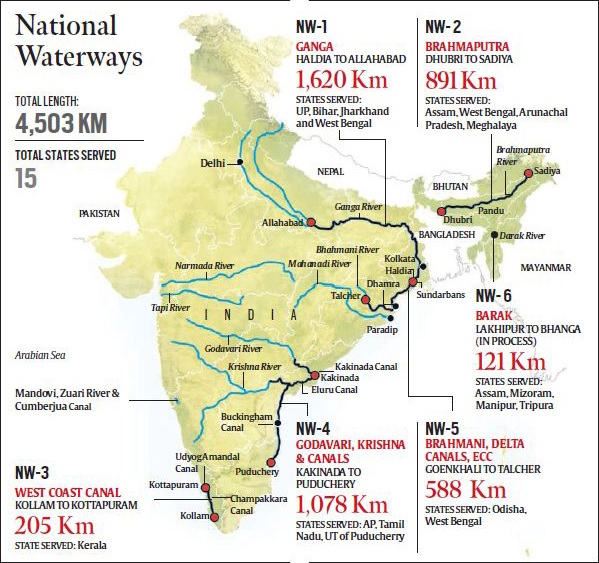Governance
Inland Vessel Bill 2021
- 18 Jun 2021
- 5 min read
Why in News
Recently, the Union Cabinet approved the Inland Vessels Bill, 2021, which will replace the Inland Vessels Act, 1917 after passing in Parliament.
- The Bill will regulate safety, security and registration of inland vessels.
Key Points
- Features of the Bill:
- A key feature of the Bill is a unified law for the entire country, instead of separate rules framed by the States.
- The certificate of registration granted under the proposed law will be deemed to be valid in all States and Union Territories, and there will be no need to seek separate permissions from the States.
- The Bill provides for a central database for recording the details of vessel, vessel registration, crew on an electronic portal.
- All non-mechanically propelled vessels will also have to be enrolled at the district, taluk or panchayat or village level.
- It enlarges the definition of ‘inland waters’, by including tidal water limit and national waterways declared by the Central Government.
- It also deals with pollution control measures of Inland Vessels. This Bill directs the Central Government to designate a list of chemicals, substances, etc. as pollutants.
- A key feature of the Bill is a unified law for the entire country, instead of separate rules framed by the States.
- Inland Waterways:
- About:
- India has about 14,500 km of navigable waterways which comprise of rivers, canals, backwaters, creeks, etc.
- As per the National Waterways Act 2016, 111 waterways have been declared as National Waterways (NWs).
- NW-1: Ganga-Bhagirathi-Hooghly River System (Prayagraj-Haldia) with length 1620 km is the longest National Waterway in India.
- The Inland Waterways Authority of India (IWAI) is implementing the Jal Marg Vikas Project (JMVP) for capacity augmentation of navigation on the Haldia-Varanasi stretch of Ganga (part of NW-1) with the technical and financial assistance of the World Bank.
- Utilization:
- About 55 million tonnes of cargo is being moved annually by IWT (Inland Water Transport), a fuel-efficient and environment-friendly mode.
- However, freight transportation by waterways is highly underutilized in the country as compared to developed countries.
- Its operations are currently restricted to a few stretches in the Ganga-Bhagirathi-Hooghly rivers, the Brahmaputra, the Barak river (northeastern India), the rivers in Goa, the backwaters in Kerala, inland waters in Mumbai and the deltaic regions of the Godavari - Krishna rivers.
- Besides these organized operations by mechanized vessels, country boats of various capacities also operate in various rivers and canals and substantial quantum of cargo and passengers are transported in this unorganized sector as well.
- In India, IWT has the potential to supplement the overburdened railways and congested roadways. In addition to cargo movement, the IWT sector also provides a convenient function in related activities such as carriage of vehicles {on Roll-on-Roll-off (Ro-Ro) mode of cross ferry} and tourism.
- About 55 million tonnes of cargo is being moved annually by IWT (Inland Water Transport), a fuel-efficient and environment-friendly mode.
- Steps Taken:
- The waterways will also be linked to the eastern and western Dedicated Freight Corridors (DFCs), as well as the Sagarmala Project, which aims to promote port-led direct and indirect development.
- Further, the provisions of the Indo-Bangladesh (Sonamura-Daudkandi) and Indo-Myanmar protocol (Kaladan) permitting transhipment of goods through Bangladesh and Myanmar waters – which, in many cases, are a continuum of India’s inland waterways – enabling quicker shipments and deeper market penetration in India’s North East.
- About:
- Inland Waterways Authority of India:
- It came into existence on 27th October 1986 for development and regulation of inland waterways for shipping and navigation.
- It primarily undertakes projects for development and maintenance of IWT (Inland Water Transport) infrastructure on national waterways through grants received from the Ministry of Shipping.
- It is headquartered at Noida (Uttar Pradesh).







